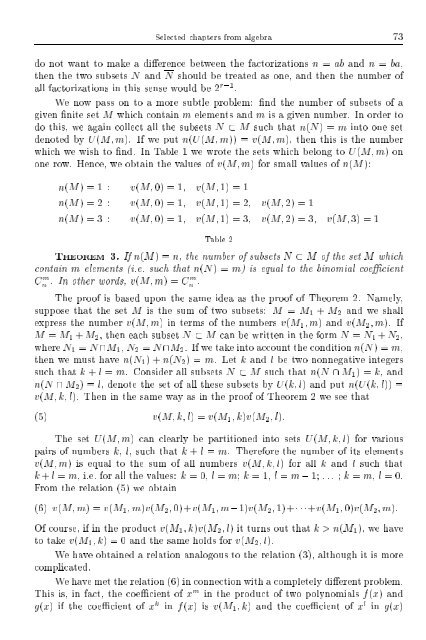SELECTED CHAPTERS FROM ALGEBRA I. R. Shafarevich Preface
SELECTED CHAPTERS FROM ALGEBRA I. R. Shafarevich Preface
SELECTED CHAPTERS FROM ALGEBRA I. R. Shafarevich Preface
Create successful ePaper yourself
Turn your PDF publications into a flip-book with our unique Google optimized e-Paper software.
Selected chapters from algebra 73do not want tomakeadierence between the factorizations n = ab and n = ba,then the two subsets N and N should be treated as one, and then the number ofall factorizations in this sense would be 2 r;1 .We now pass on to a more subtle problem: nd the number of subsets of agiven nite set M which contain m elements and m is a given number. In order todo this, we again collect all the subsets N M such that n(N) =m into one setdenoted by U(Mm). If we put n(U(Mm)) = v(Mm), then this is the numberwhich wewishtond. In Table 1 we wrote the sets which belong to U(Mm) onone row. Hence, we obtain the values of v(Mm) for small values of n(M):n(M) =1 : v(M0) = 1 v(M1) = 1n(M) =2 : v(M0) = 1 v(M1) = 2 v(M2) = 1n(M) =3 : v(M0) = 1 v(M1) = 3 v(M2) = 3 v(M3)=1Table 2THEOREM 3. If n(M) =n, the number of subsets N M of the set M whichcontain m elements (i.e. such that n(N) =m) isequal to the binomial coecientC m n . In other words, v(Mm) =Cm n .The proof is based upon the same idea as the proof of Theorem 2. Namely,suppose that the set M is the sum of two subsets: M = M 1 + M 2 and we shallexpress the number v(Mm) in terms of the numbers v(M 1 m)andv(M 2 m). IfM = M 1 + M 2 , then each subset N M can be written in the form N = N 1 + N 2 ,where N 1 = N \M 1 , N 2 = N \M 2 . If wetakeinto account the condition n(N) =m,then we must have n(N 1 )+n(N 2 )=m. Let k and l be two nonnegative integerssuch thatk + l = m. Consider all subsets N M such that n(N \ M 1 )=k, andn(N \ M 2 )=l, denote the set of all these subsets by U(k l) andputn(U(k l)) =v(Mkl). Then in the same way as in the proof of Theorem 2 we see that(5) v(Mkl) =v(M 1 k)v(M 2 l):The set U(Mm) can clearly be partitioned into sets U(Mkl) for variouspairs of numbers k, l, such that k + l = m. Therefore the number of its elementsv(Mm) is equal to the sum of all numbers v(Mkl) for all k and l such thatk + l = m, i.e. for all the values: k =0,l = m k =1,l = m ; 1 ... k = m, l =0.From the relation (5) we obtain(6) v(Mm) =v(M 1 m)v(M 2 0)+v(M 1 m;1)v(M 2 1)++v(M 1 0)v(M 2 m):Of course, if in the product v(M 1 k)v(M 2 l)itturnsoutthatk>n(M 1 ), we haveto take v(M 1 k) = 0 and the same holds for v(M 2 l).We have obtained a relation analogous to the relation (3), although it is morecomplicated.Wehave met the relation (6) in connection with a completely dierent problem.This is, in fact, the coecient ofx m in the product of two polynomials f(x) andg(x) if the coecient of x k in f(x) is v(M 1 k) and the coecient of x l in g(x)
















